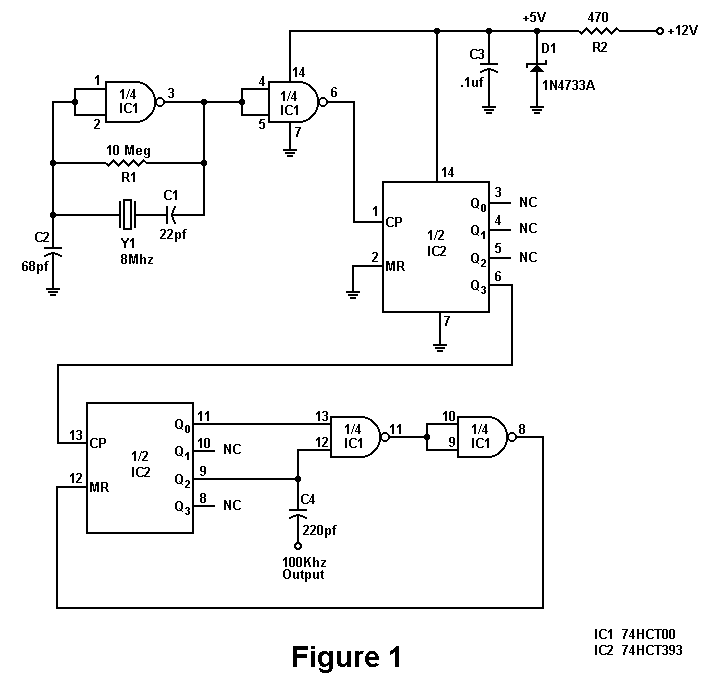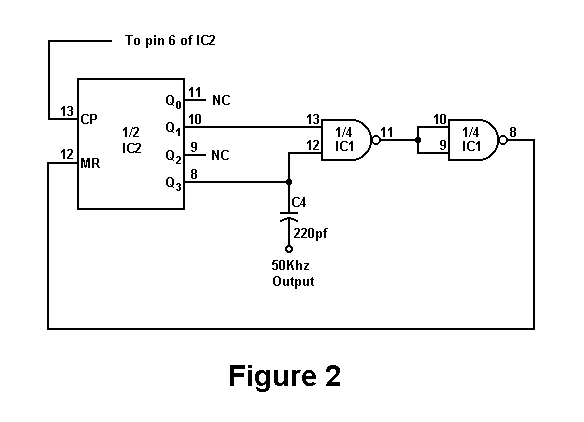|
高稳定100KHz时钟发生电路,100khz clock generator
关键字:高稳定100KHz时钟发生电路
Build A 100Khz Crystal Calibrator
By N1HFX
There is a great deal of old amateur gear which many amateurs have decided to restore and bring back to life. While much of the early amateur transceivers work just fine they usually lack a digital readout and must rely on analog dials for tuning. The problem of dial calibration is complicated by the non-linear effects of tuning capacitors. This month's circuit is a 100Khz crystal calibrator using an inexpensive microprocessor crystal and CMOS IC's which are readily available at Radio Shack.
The main problem with building a 100Khz oscillator is the unavailability of 100Khz crystals. Even if you find a vendor willing to cut such a crystal for you, plan on paying $20 or more not including shipping charges. The circuit in Figure 1 uses an inexpensive 8Mhz microprocessor crystal which can be easily obtained from most parts suppliers for about $1. Using a 74HCT393 binary counter IC, we can easily divide down the 8 MHz signal from our crystal into 100Khz or almost any frequency we need.
The circuit in Figure 1 uses a couple of NAND gates (74HCT00 IC) for our 8Mhz crystal oscillator. Capacitor C2 actually helps us tune the crystal to the exact frequency, Use any value of C2 from about 22pf to about 82pf to get the oscillator on frequency. In the prototype, 68pf worked fine for most of the crystals tested. For an exact frequency, replace C2 with a 22pf and add a 50pf trimmer capacitor in parallel. By adjusting the 50pf trimmer capacitor, we can easily get the crystal exactly on frequency. The first NAND gate is our oscillator while the second NAND gate acts as a buffer and conditions the signal. This signal is then fed into the clock pulse input of one of the 4 bit binary counters in IC2. By taking the output from the Q3 signal, we have now divided the signal by 16 giving us 500Khz. This signal is now fed into the clock pulse input of the second 4 bit binary counter. In the first counter we tied the MR (clock reset) line to ground. In the second counter, we need the count to reset when we reach a binary five, which will allow us to divide the 500Khz by 5. For this counter, we used the last 2 remaining NAND gates in IC1 to detect the desired value. When we reach the correct reset interval, the MR line goes high resetting the counter to zero and allowing us to effectively divide by 5. The 100Khz output is taken from the Q2 line and is coupled through capacitor C4.
If you prefer, this circuit can be easily changed to a 50Khz calibrator by wiring pins 13 & 14 of IC1 into pins 10 and 8 of IC2. See Figure 2 for details. This arrangement makes the second counter reset at binary 10 which divides the 500Khz by 10 giving us the desired 50Khz.
The HCT series CMOS logic IC's require a 5 volt power supply just like the old TTL logic series. In this circuit we used a 5 volt zener diode, D1, along with resistor R2 to get 12 volts down to 5 volts. Capacitor C3 is used primarily for bypassing the oscillator and must be used in this circuit. If you prefer to power this circuit from a 9 volt battery, then reduce resistor R2 to 220 ohms for best performance.
If you plan to install this circuit inside a transceiver, feed the output directly to the receiver front end. Make certain you have connected it after the TR relay so that the circuit doesn't get zapped by RF from the transmitter side. Also, you will want to install an ON/OFF switch which will interrupt the 12V line going to the circuit. As with all static sensitive CMOS IC's, use special handling precautions and do not leave out those IC sockets.
This circuit has been found to generate accurate birdies at every 100Khz and will be an excellent aid in getting that old rig right on frequency. The accuracy of the 100Khz birdies will depend on how close the 8Mhz oscillator is on frequency. With the difficulty in getting crystals for specific frequencies, this circuit gives new meaning to the words "Divide and Conquer".
要产生100千赫兹频率的电路,如果采用晶体管搭建的LC震荡电路,当要求频率很稳定时比较困难,而采用晶体震荡器则容易实现,而低频率的晶体震荡器又不容易获得,下面的电路就能够将频率较高的晶体震荡器通过适当的电路输出频率较低的信号。
电路原理简单,通过IC1的门电路,晶体以及外围电路组成8M赫兹震荡器,通过IC2分频获得100千赫兹信号。
DE N1HFX

下图是产生50千赫兹的电路,13脚接上图的IC2的6脚就可以了。

元件清单
Parts List
| C1 |
|
22 picofarad ceramic disk capacitor |
| C2 |
|
68 picofarad ceramic disk capacitor (see text) |
| C3 |
|
.1 microfarad ceramic disk capacitor |
| C4 |
|
220 picofarad ceramic disk capacitor |
| R1 |
|
10 Meg ohm 1/4 watt 5% resistor |
| R2 |
|
470 ohm 1/4 watt 5% resistor |
| D1 |
|
5.1 volt zener diode 1N4733A (RS 276-565) |
| IC1 |
|
74HCT00 quad 2 input NAND gate IC (RS 276-2801) |
| IC2 |
|
74HCT393 dual 4 bit binary ripple counter IC (RS 276-2884) |
| Y1 |
|
8 MHz HC49U microprocessor crystal (MOUSER 520-HCA800-20 or DIGI-KEY X021-ND) The auther has a large number of these crystals in stock and will make them available at cost upon request. |
|